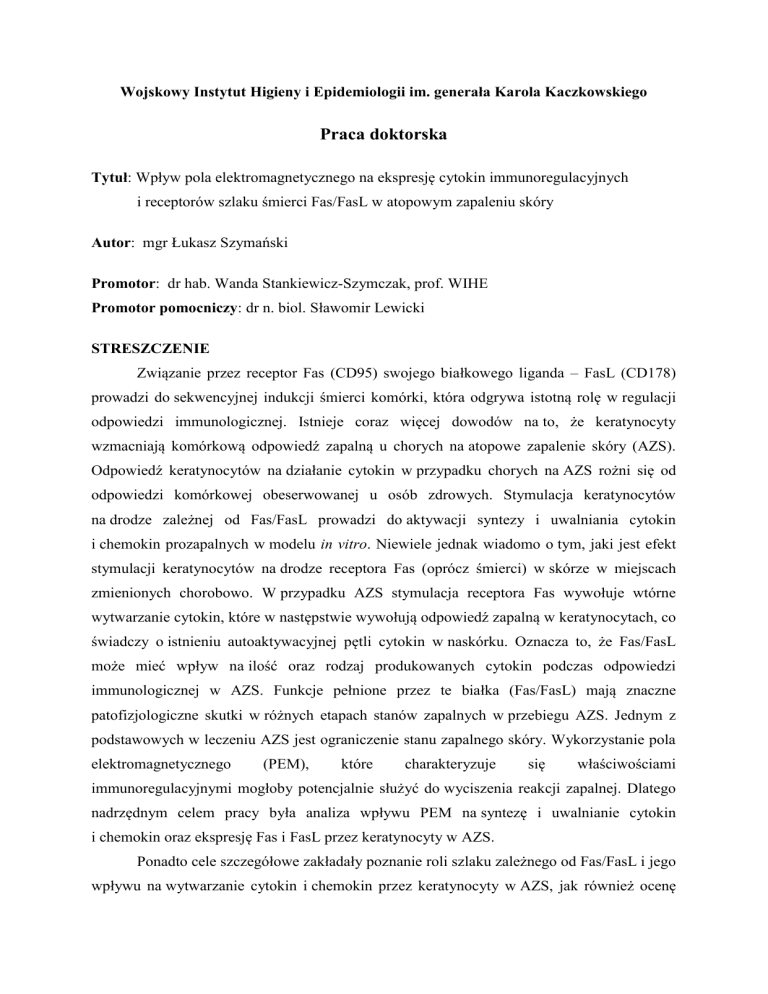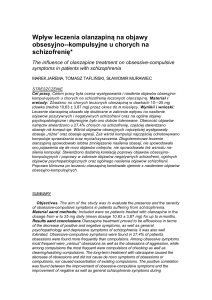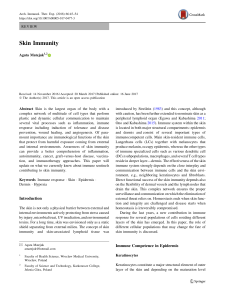
Wojskowy Instytut Higieny i Epidemiologii im. generała Karola Kaczkowskiego
Praca doktorska
Tytuł: Wpływ pola elektromagnetycznego na ekspresję cytokin immunoregulacyjnych
i receptorów szlaku śmierci Fas/FasL w atopowym zapaleniu skóry
Autor: mgr Łukasz Szymański
Promotor: dr hab. Wanda Stankiewicz-Szymczak, prof. WIHE
Promotor pomocniczy: dr n. biol. Sławomir Lewicki
STRESZCZENIE
Związanie przez receptor Fas (CD95) swojego białkowego liganda – FasL (CD178)
prowadzi do sekwencyjnej indukcji śmierci komórki, która odgrywa istotną rolę w regulacji
odpowiedzi immunologicznej. Istnieje coraz więcej dowodów na to, że keratynocyty
wzmacniają komórkową odpowiedź zapalną u chorych na atopowe zapalenie skóry (AZS).
Odpowiedź keratynocytów na działanie cytokin w przypadku chorych na AZS rożni się od
odpowiedzi komórkowej obeserwowanej u osób zdrowych. Stymulacja keratynocytów
na drodze zależnej od Fas/FasL prowadzi do aktywacji syntezy i uwalniania cytokin
i chemokin prozapalnych w modelu in vitro. Niewiele jednak wiadomo o tym, jaki jest efekt
stymulacji keratynocytów na drodze receptora Fas (oprócz śmierci) w skórze w miejscach
zmienionych chorobowo. W przypadku AZS stymulacja receptora Fas wywołuje wtórne
wytwarzanie cytokin, które w następstwie wywołują odpowiedź zapalną w keratynocytach, co
świadczy o istnieniu autoaktywacyjnej pętli cytokin w naskórku. Oznacza to, że Fas/FasL
może mieć wpływ na ilość oraz rodzaj produkowanych cytokin podczas odpowiedzi
immunologicznej w AZS. Funkcje pełnione przez te białka (Fas/FasL) mają znaczne
patofizjologiczne skutki w różnych etapach stanów zapalnych w przebiegu AZS. Jednym z
podstawowych w leczeniu AZS jest ograniczenie stanu zapalnego skóry. Wykorzystanie pola
elektromagnetycznego
(PEM),
które
charakteryzuje
się
właściwościami
immunoregulacyjnymi mogłoby potencjalnie służyć do wyciszenia reakcji zapalnej. Dlatego
nadrzędnym celem pracy była analiza wpływu PEM na syntezę i uwalnianie cytokin
i chemokin oraz ekspresję Fas i FasL przez keratynocyty w AZS.
Ponadto cele szczegółowe zakładały poznanie roli szlaku zależnego od Fas/FasL i jego
wpływu na wytwarzanie cytokin i chemokin przez keratynocyty w AZS, jak również ocenę
możliwości
zastąpienia
hodowli
pierwotnych
ludzkich
keratynocytów
komercyjnie
dostępnymi liniami komórkowymi takimi jak HaCaT i PSC-200-010.
Badania wykonano na grupie badanej wynoszącej 20 pacjentów chorych na AZS,
grupie kontrolnej wynoszącej 20 osób zdrowych i 10 niezależnych powtórzeń badań
przeprowadzonych na liniach komórkowych HaCaT i PSC-200-010.
Wyniki
przeprowadzonych
badań
wykazały
duży
i różnorodny
wpływ
immunomodulujący PEM na przebieg AZS. W keratynocytach uzyskanych od osób chorych
na AZS, ekspozycja na PEM powoduje spadek ekspresji Fas (2,211 ± 1,048; 6,55 ± 2,88 %
w 4-tej godzinie badania i 2,148 ± 0,633; 7,174 ± 1,073 % w 24-tej godzinie badania) i FasL
(1,85 ± 1,043; 4,286 ± 1,469 % w 4-tej godzinie badania i 1,292 ± 0,872; 5,465 ± 1,418 %
w 24-tej godzinie badania) w stosunku do kontroli.
60 minutowa ekspozycja hodowli keratynocytów uzyskanych od pacjentów chorych
na AZS na PEM spowodowała prawie natychmiastowe i krótkotrwałe (trwający krócej niż 24
godz.) obniżenie stężenia IL-12, IL-17, IL-31 i TNF, oraz długotrwałe (trwający dłużej niż 24
godz.) obniżenie stężenia IL-4, IL-10 i IL-13. Co więcej, ekspozycja na PEM spowodowała
w 24-tej godzinie eksperymentu spadek stężenia IL-1β w nadsączach hodowli komórkowych
uzyskanych od pacjentów chorych na AZS, a w hodowlach komórek uzyskanych od osób
zdrowych spowodowała prawie natychmiastowy i krótkotrwały (trwający krócej niż 24 godz.)
wzrost stężenia IL-1β. Ekspozycja na PEM spowodowała również wzrost produkcji IL-8 (w
24-tej godzinie badania) w keratynocytach uzyskanych od osób zdrowych i chorych na AZS.
W linii HaCaT ekspozycja na PEM powodowała obniżenie ekspresji receptora Fas
w 24-tej godzinie badania oraz podwyższenie ekspresji liganda FasL w 4-tej godzinie
badania. Ekspozycja komórek linii PSC-200-010 na PEM spowodowała wzrost ekspresji
receptora Fas i jego liganda FasL w 4-tej godzinie badania. Ekspozycja komórek linii PSC200-010 na PEM, powodowała jedynie spadek wydzielania IL-8 w stosunku do kontroli
(281,2 ± 19,57; 317,3 ± 35,18 pg/mL w 4-tej godzinie badania i 69,5 ± 37,96; 121,8 ± 52,64
pg/mL w 24-tej godzinie badania). Ekspozycja keratynocytów ustalonej linii HaCaT na PEM
nie powodowała statystycznie istotnych różnic w stężeniach badanych cytokin i chemokin
w nadsączach z hodowli komórkowych.
W ramach zrealizowanej pracy wykazano, że:
Profil ekspresji receptora Fas i jego liganda FasL jest inny w keratynocytach uzyskanych
od osób chorych na AZS w stosunku do keratynocytów uzyskanych od osób zdrowych.
Profil ekspresji cytokin i chemokiny jest inny w keratynocytach uzyskanych od osób
chorych na AZS w stosunku do keratynocytów uzyskanych od osób zdrowych.
Pole elektromagnetyczne wykazuje silne działanie immunomodulujące na keratynocyty
wyizolowanych ze skóry pacjentów chorych na AZS.
Ekspozycja na PEM może powodować wzrost wydzielania IL-8 u osób zdrowych.
PEM może zostać potencjalnie wykorzystane jako terapia wspomagająca w AZS.
Profil ekspresji receptora Fas i jego liganda FasL jak również cytokin i chemokiny jest
inny w keratynocytach komercyjnie dostępnych linii komórkowych HaCaT i PSC-200-010
niż w keratynocytach uzyskanych od osób zdrowych.
Komórki linii HaCaT i PSC-200-010 nie mogą zastąpić keratynocytów uzyskanych od
osób zdrowych w badaniach naukowych.
NF-κβ i kinazy z rodziny MAP to prawdopodobne miejsce regulacji wpływu PEM na szlak
zależny od Fas/FasL oraz cytokiny i chemokiny w ludzkich keratynocytach zdrowych jak
i zmienionych przez AZS.
Title: The impact of the electromagnetic field on the expression of immunoregulatory
cytokines and Fas/FasL dependent pathway receptor and ligand in atopic dermatitis.
Abstract
Binding of the Fas receptor (CD95) to its protein ligand - FasL (CD178) results in the
sequential induction of cell death that plays a significant role in the mechanisms of T cell
cytotoxicity, and regulation of the immune response. There is increasing evidence that the
keratinocytes (skin cells) enhance cellular inflammatory response in patients with atopic
dermatitis (AD). Keratinocyte response to cytokine influence is different in patients with
atopic dermatitis than in healthy subjects. Fas/FasL dependent stimulation of keratinocytes
leads to the activation of the production of proinflammatory cytokine and chemokines in the
in vitro model. It is known that Fas/FasL death receptors are expressed on keratinocytes, but
there is no evidence of extensive apoptosis of these cells, suggesting that non-apoptotic
mechanism of Fas/FasL pathway is commonly encountered, although not examined in the
case of atopic dermatitis, phenomenon. Moreover, it has been shown that FasL induces
production of secondary cytokines, which trigger in keratinocytes the following inflammatory
response - this indicates the existence of an autoactivating loop of cytokines in the atopic skin.
Thus, the Fas/FasL pathway have a wider range of functions in the skin than previously
suspected, and may act as a potential starting point for further cutaneous inflammation. The
function of these proteins (Fas/FasL), have significant pathophysiological effects in different
stages of inflammation in AD. Since in AD it is especially important to reduce the
inflammation
of
the
skin,
electromagnetic
field,
which
have
immunoregulatory
characteristics, may be potentially used. Therefore, the main objective of this study was to
analyze the effect of the EMF on the production of cytokines and chemokines, as well as
expression of Fas and FasL in atopic skin keratinocytes.
In addition, specific objectives included understanding of the Fas/FasL dependent
pathway and its impact on the cytokine and chemokine production by skin keratinocytes in
atopic dermatitis, as well as evaluating the possibility of replacing primary cultures of human
keratinocytes by commercially available cell lines such as HaCaT and PSC-200-010.
The research included 20 patients with AD in the study group, 20 healthy subjects in
the control group and 10 independent repeats for HaCaT and PSC-200-010 cell lines.
The results of this study showed a large and diverse immunomodulatory effects of
EMF in AD. Exposure of keratinocytes obtained from people with atopic dermatitis to the
EMF resulted in a decrease of the expression of Fas (2.211 ± 1.048; 6.55 ± 2.88% in the 4th
hour of the study and 2,148 ± 0.633; 7.174 ± 1.073% in the 24th hour of the experiment) and
FasL (1.85 ± 1.043; 4.286 ± 1.469% in the 4th hour of the experiment and 1.292 ± 0.872;
5.465 ± 1.418% in the 24th hour) when compared to healthy controls.
60 min exposure of the keratinocyte cultures, derived from patients, with AD to the
EMF caused almost immediate and short-term (less than 24h) decrease in the concentration of
IL-12, IL-17, IL-31 and TNF, and long-term (more than 24h) decrease in the concentration of
IL-4, IL-10 and IL-13 in the culture supernatants. Moreover, exposure to EMF resulted in the
decreased concentration of IL-1β in supernatants of cell cultures obtained from patients with
AD (24th hour of the experiment), and almost immediate and short-term (less than 24h)
increase in the concentration of IL-1β in supernatants of cells derived from healthy subjects.
Exposure to the EMF has also caused increased secretion of IL-8 (24th hour of the
experiment) in keratinocytes obtained, from both, healthy subjects and patients with AD.
Exposure to EMF of the HaCaT cell line resulted in a decrease of the Fas expression in
the 24th hour of the experiment, and in an increase of the FasL expression in the 4th hour of
the experiment. PSC-200-010 cells exposure to EMF caused increased expression of both, Fas
and its ligand FasL, in the 4th hour of the experiment. Moreover, in PSC-200-010 cell line
EMF exposure resulted in a decrease of the IL-8 when compared to the healthy control (281.2
± 19.57; 35.18 ± 317.3 pg/mL in the 4th hour of the experiment and 69 5 ± 37.96; 121.8 ±
52.64 pg/mL in the 24th hour of the experiment). There were no statistically significant
differences in the secretion of the cytokines and chemokine in HaCaT cells.
Experiments realized within this dissertation demonstrated that:
The expression profile of the Fas receptor and its ligand FasL is different between
keratinocytes derived from patients with AD compared to keratinocytes obtained from
healthy individuals.
The cytokine and chemokine expression profile is different in keratinocytes derived from
patients with AD compared to keratinocytes obtained from healthy subjects.
The electromagnetic field has a strong immunomodulatory effect on keratinocytes
obtained from the skins of patients with AD.
Exposure of keratinocytes to EMF can increase the secretion of IL-8 in the cells of
healthy subjects.
EMF can potentially be used as adjunctive therapy in AD.
The expression profile of the cytokines and chemokines, as well as Fas receptor and its
ligand FasL is different in commercially available keratinocyte cell lines (HaCaT and
PSC-200-010) than in keratinocytes obtained from healthy individuals.
HaCaT and PSC-200-010 cell lines cannot substitute keratinocytes obtained from healthy
subjects in scientific research.
NF-κβ and MAP kinase family is a most probable place of the regulation of EMF
influence on the Fas/FasL dependent pathway and cytokine and chemokine expression
profile in human keratinocytes derived from both heathy and atopic skin.




